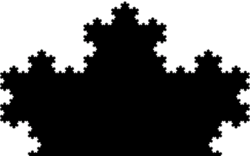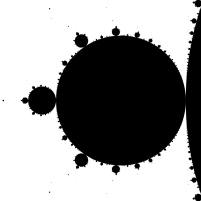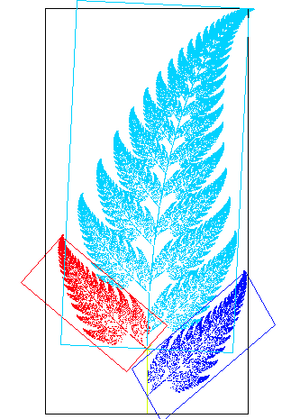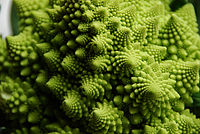Self-similarity


In
A time developing phenomenon is said to exhibit self-similarity if the numerical value of certain observable quantity measured at different times are different but the corresponding dimensionless quantity at given value of remain invariant. It happens if the quantity exhibits dynamic scaling. The idea is just an extension of the idea of similarity of two triangles.[3][4][5] Note that two triangles are similar if the numerical values of their sides are different however the corresponding dimensionless quantities, such as their angles, coincide.
Peitgen et al. explain the concept as such:
If parts of a figure are small replicas of the whole, then the figure is called self-similar....A figure is strictly self-similar if the figure can be decomposed into parts which are exact replicas of the whole. Any arbitrary part contains an exact replica of the whole figure.[6]
Since mathematically, a fractal may show self-similarity under indefinite magnification, it is impossible to recreate this physically. Peitgen et al. suggest studying self-similarity using approximations:
In order to give an operational meaning to the property of self-similarity, we are necessarily restricted to dealing with finite approximations of the limit figure. This is done using the method which we will call box self-similarity where measurements are made on finite stages of the figure using grids of various sizes.[7]
This vocabulary was introduced by Benoit Mandelbrot in 1964.[8]
Self-affinity

In
Definition
A
If , we call X self-similar if it is the only
a self-similar structure. The homeomorphisms may be
The automorphisms of the dyadic monoid is the modular group; the automorphisms can be pictured as hyperbolic rotations of the binary tree.
A more general notion than self-similarity is
Examples


The Mandelbrot set is also self-similar around Misiurewicz points.
Self-similarity has important consequences for the design of computer networks, as typical network traffic has self-similar properties. For example, in
Similarly,
In cybernetics
The viable system model of Stafford Beer is an organizational model with an affine self-similar hierarchy, where a given viable system is one element of the System One of a viable system one recursive level higher up, and for whom the elements of its System One are viable systems one recursive level lower down.
In nature

Self-similarity can be found in nature, as well. To the right is a mathematically generated, perfectly self-similar image of a fern, which bears a marked resemblance to natural ferns. Other plants, such as Romanesco broccoli, exhibit strong self-similarity.
In music
- Strict fugues.
- A Shepard tone is self-similar in the frequency or wavelength domains.
- The Danish composer Per Nørgård has made use of a self-similar integer sequence named the 'infinity series' in much of his music.
- In the research field of music information retrieval, self-similarity commonly refers to the fact that music often consists of parts that are repeated in time.[12] In other words, music is self-similar under temporal translation, rather than (or in addition to) under scaling.[13]
See also
- Droste effect
- Golden ratio
- Logarithmic spiral
- Long-range dependency
- Non-well-founded set theory
- Recursion
- Self-dissimilarity
- Self-reference
- Self-replication
- Self-similarity of network data analysis
- Self-similar process
- Teragon
- Tessellation
- Tweedie distributions
- Zipf's law
- Fractal
References
- ISBN 978-0716711865.
- S2CID 15700641.)
{{cite journal}}: CS1 maint: multiple names: authors list (link - S2CID 26023004.
- .
- ISBN 3-540-97346-X.
- ^ Peitgen, et al (1991), p.2-3.
- ^ Comment j'ai découvert les fractales, Interview de Benoit Mandelbrot, La Recherche https://www.larecherche.fr/math%C3%A9matiques-histoire-des-sciences/%C2%AB-comment-jai-d%C3%A9couvert-les-fractales-%C2%BB
- S2CID 6011907.
- ^ Benoit Mandelbrot (February 1999). "How Fractals Can Explain What's Wrong with Wall Street". Scientific American.
- ISBN 978-0691043012
- (PDF) from the original on 9 August 2017.
- ISBN 978-952-5431-32-2. Archived from the original (PDF) on 8 February 2017. Retrieved 30 July 2018. (Also see Google Books)
External links
- "Copperplate Chevrons" — a self-similar fractal zoom movie
- "Self-Similarity" — New articles about Self-Similarity. Waltz Algorithm
Self-affinity
- Mandelbrot, Benoit B. (1985). "Self-affinity and fractal dimension" (PDF). Physica Scripta. 32 (4): 257–260. S2CID 250815596.
- Sapozhnikov, Victor; Foufoula-Georgiou, Efi (May 1996). "Self-Affinity in Braided Rivers" (PDF). Water Resources Research. 32 (5): 1429–1439. (PDF) from the original on 30 July 2018. Retrieved 30 July 2018.
- Benoît B. Mandelbrot (2002). Gaussian Self-Affinity and Fractals: Globality, the Earth, 1/F Noise, and R/S. Springer. ISBN 978-0387989938.






